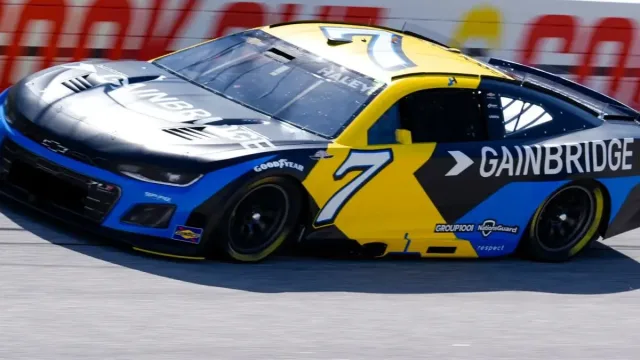- Jeff Dickerson highlighted a lack of energy, chemistry, and communication as primary reasons for parting ways with Rodney Childers.
- The decision to separate from Childers was not influenced by his track performance metrics or previous successes.
- Childers’ departure was driven by broader issues of culture clash and misalignment of mutual goals with Spire Motorsports.
- Dickerson emphasized the importance of timing in leadership changes to maintain team synergy and success.
- Proactive change was deemed necessary by both parties to address the ineffective collaboration between Childers and Spire.
The Rise and Shake-Up at Spire Motorsports
Spire Motorsports has always thrived on its reputation as an underdog with a rebellious edge. Since its surprise Daytona victory in 2019, the team has welcomed its outsider status with pride.
By 2025, Spire had transformed, showcasing larger resources and ambitions. This evolution brought heightened expectations, yet also introduced complexities. The team’s performance oscillated between potential and inconsistency.
Justin Haley, steering the #7 car, was supported by a crew with championship pedigree, hinting at promising prospects.
However, an unforeseen development rattled the team’s foundation. Nine races into the season, Spire unexpectedly parted ways with esteemed crew chief Rodney Childers. This decision reverberated through the garage, as Childers was perceived as vital for propelling Spire to prominence.
Despite only securing a single top-10 finish, the official narrative diverged from mere performance metrics. The shake-up highlighted the intricate dynamics at play within the rapidly evolving team framework.

The Decision to Part Ways and Its Reasons
Announced abruptly on April 23, 2025, the separation between Spire Motorsports and Rodney Childers puzzled many in the racing community.
Despite Childers’ pedigree as a Cup Series champion with 40 wins, the decision to part ways was not driven by on-track performance.
Jeff Dickerson, representing Spire, acknowledged the move seemed counterintuitive at initial glance, yet emphasized it was a deliberate, tactical decision.
“It looks like we are just pulling this out of our a**. You don’t get to date before you get married.”
“This wasn’t about results.” – Jeff Dickerson
Why did @SpireMotorsport part ways with @RodneyChilders4? I spoke to Jeff Dickerson to get some answers here: https://t.co/pFjP9gbyKt
— Jeff Gluck (@jeff_gluck) April 25, 2025
The root issue lay in the intangible dynamics within the team—specifically, a lack of energy, chemistry, and effective communication between Childers and driver Justin Haley. Both were characterized as quiet and methodical, leading to a stagnant atmosphere that impeded momentum.
Although the team was not underperforming, Spire chose to act swiftly rather than endure a prolonged mismatch. Even Haley, the driver himself, was taken aback by the decision, underscoring its unexpected nature.
Culture Clash and Leadership Fit
The separation between Spire Motorsports and Rodney Childers may have been rooted in interpersonal dynamics, but it emphasizes a broader issue: culture clash and leadership fit.
Despite acknowledging Childers as a team player, Jeff Dickerson recognized that alignment on expectations was lacking. This decision highlights the significance of synergy between leadership styles and organizational culture.
Key elements to reflect on include:
- Expectation Alignment: Both sides failed to converge on mutual goals, a vital component for effective collaboration.
- Proactive Change: Dickerson emphasized the necessity for proactive change, reflecting Spire’s philosophy of initiating rather than reacting to change.
- Strategic Timing: While Spire’s approach mirrors a Legacy Motor Club strategy, it reiterates the importance of timing in leadership decisions.

Aftermath and Technical Issues at Talladega
Despite the tactical move of appointing Ryan Sparks as the new crew chief for the #7 Chevy team, Spire Motorsports faced unforeseen challenges at Talladega. Sparks, with his intimate knowledge of the team’s dynamics, seemed a promising choice.
However, technical issues marred their preparations for the Jack Link’s 500 race. Justin Haley’s race car failed the initial tech inspection twice, leading to the ejection of the car chief and a loss of pit selection. This misstep required the car to pass inspection on a subsequent attempt, contrasting with most other teams, who cleared by the second try.
These setbacks cast doubt on Spire’s decision to part ways with the seasoned Rodney Childers, only nine races into the season. The tactical gamble to replace an experienced leader with Sparks, despite his expertise, emerged as a risky choice.
 Talladega Superspeedway VIP Experience” width=”1200″ height=”800″ srcset=”https://slicksandsticks.com/wp-content/uploads/2025/04/Talladega-Superspeedway-VIP-Experience.webp 1200w, https://slicksandsticks.com/wp-content/uploads/2025/04/Talladega-Superspeedway-VIP-Experience-300×200.webp 300w, https://slicksandsticks.com/wp-content/uploads/2025/04/Talladega-Superspeedway-VIP-Experience-1024×683.webp 1024w, https://slicksandsticks.com/wp-content/uploads/2025/04/Talladega-Superspeedway-VIP-Experience-768×512.webp 768w, https://slicksandsticks.com/wp-content/uploads/2025/04/Talladega-Superspeedway-VIP-Experience-630×420.webp 630w, https://slicksandsticks.com/wp-content/uploads/2025/04/Talladega-Superspeedway-VIP-Experience-150×100.webp 150w, https://slicksandsticks.com/wp-content/uploads/2025/04/Talladega-Superspeedway-VIP-Experience-696×464.webp 696w, https://slicksandsticks.com/wp-content/uploads/2025/04/Talladega-Superspeedway-VIP-Experience-1068×712.webp 1068w” sizes=”auto, (max-width: 1200px) 100vw, 1200px” />
Talladega Superspeedway VIP Experience” width=”1200″ height=”800″ srcset=”https://slicksandsticks.com/wp-content/uploads/2025/04/Talladega-Superspeedway-VIP-Experience.webp 1200w, https://slicksandsticks.com/wp-content/uploads/2025/04/Talladega-Superspeedway-VIP-Experience-300×200.webp 300w, https://slicksandsticks.com/wp-content/uploads/2025/04/Talladega-Superspeedway-VIP-Experience-1024×683.webp 1024w, https://slicksandsticks.com/wp-content/uploads/2025/04/Talladega-Superspeedway-VIP-Experience-768×512.webp 768w, https://slicksandsticks.com/wp-content/uploads/2025/04/Talladega-Superspeedway-VIP-Experience-630×420.webp 630w, https://slicksandsticks.com/wp-content/uploads/2025/04/Talladega-Superspeedway-VIP-Experience-150×100.webp 150w, https://slicksandsticks.com/wp-content/uploads/2025/04/Talladega-Superspeedway-VIP-Experience-696×464.webp 696w, https://slicksandsticks.com/wp-content/uploads/2025/04/Talladega-Superspeedway-VIP-Experience-1068×712.webp 1068w” sizes=”auto, (max-width: 1200px) 100vw, 1200px” />
News in Brief: Spire Motorsports Leadership Shake-Up
In the wake of Rodney Childers’ departure from Spire Motorsports, the team faces a period of reflection and adjustment. Jeff Dickerson’s candid admission about the decision emphasizes a critical juncture in the team’s evolution. While the split was driven by a clash in culture and leadership vision, the immediate aftermath, highlighted by mechanical issues at Talladega, suggests challenges ahead. As Spire Motorsports navigates this shift, the focus turns to finding unity and stability for future success.
ALSO READ: NASCAR Shockwave: Rodney Childers Exits Spire Motorsports After Just Nine Races!
